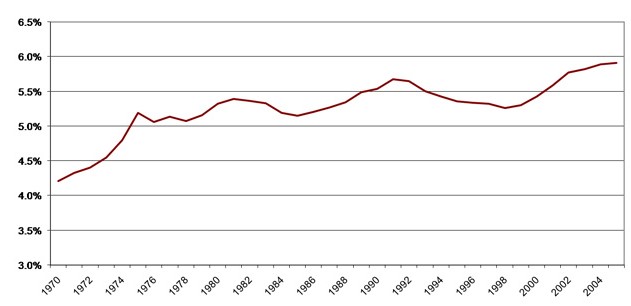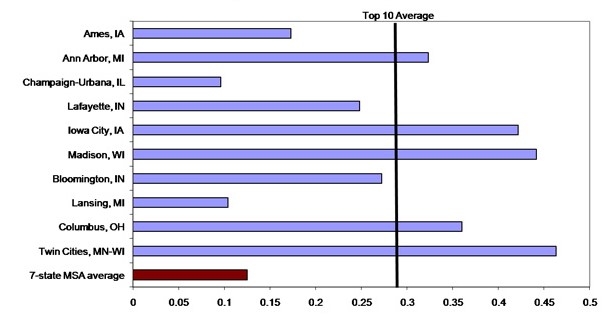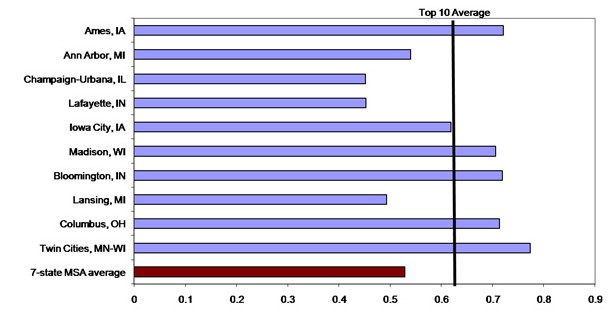University Cities
It’s very clear by now that wages and incomes have risen sharply for U.S. workers who have attained greater education. One recent study indicates that the premium of hourly wages of college graduates over those with only a high school diploma has climbed from just over 30% in 1950 to over 60% today. This lesson has not been lost on recent high school graduates. The U.S. Bureau of Labor Statistics reports that in October 2007, 67.2% of the class of 2007 high school graduates were enrolled in a postsecondary educational program.
So, how have rising returns to education affected the economic growth and well-being of places? Not surprisingly, eminent scholars have proffered that those local economies having highly educated work forces have outperformed as measured by relative income and employment growth. In particular, research papers by Edward Glaeser (and others) provide documentation that a large initial work force share having a college degree in a metropolitan area tends to give rise to strong subsequent growth in jobs and income.
Metropolitan areas and other local areas in the Northeast and Midwest have taken especial note. Here, the economic performance of many cities has been hampered by an industrial composition steeped in traditional manufacturing. While the skill and educational requirements of factory jobs have been notably climbing as of late, the economic structure of many Midwest places has not developed from a strong base—that is, one having the advanced business, finance, and professional services that tend to employ highly educated and highly compensated workers.
One place in the region where we still might expect to observe the propulsive power of educational attainment would be in the Midwest’s college and university towns. Both nationally and regionally, colleges and universities have enjoyed rising demand for their services—both research and teaching. Per the graph below, enrollments as a share of the U.S. population continue to rise during the current decade, reaching almost 6.5%—a level of 18 million by October 2007 (versus 8.2 million in 1970). So, too, research and development (R&D) performed by colleges and universities has also climbed over same period, rising from a 9.2% share of all U.S. R&D in 1970 to a 13.7% share in 2006. More recently (measured in nominal dollars), university R&D rose by 50% over the period 1999–2006.
1. Post-secondary enrollment (percent of population)

Such trends have driven direct employment in academia higher. According to surveys conducted by the American Association of University Professors, over the past three decades, “while the number of tenured and tenure-track faculty has grown 17 percent, the ranks of contingent faculty (both part and full time) and full-time nonfaculty professionals have each tripled, and the count of administrators has doubled.”
In addition to direct employment, university research has often acted as a catalyst for growth in the private sector. Technology transfer from university labs to start-ups and early stage firms has become a growing activity. Moreover, many such firm start-ups take root locally in university towns themselves. The emergence of industrial research parks adjacent to or close by universities offer testament to this phenomenon—with those in proximity to Stanford University and the Massachusetts Institute of Technology (MIT), as well as the Research Triangle Park in North Carolina, being the prominent prototypes.
To identify those Midwest metropolitan statistical areas (MSAs) in the Great Lakes region where universities make up a large share of economic activity, we look at the R&D expenditures of all universities in each MSA in seven states—Illinois, Indiana, Iowa, Michigan, Minnesota, Ohio, and Wisconsin. On a per capita basis, the top ten metropolitan areas by R&D expenditures for 1979 are reported in the graphs below (by rank from highest to lowest). How did these metropolitan areas subsequently perform as measured by population growth and per capita income?
In answering this question, it must be recognized that much more than university activity has transpired in these metropolitan areas. Even metropolitan areas that we tend to associate with major universities (e.g., Lafayette, Indiana, with Purdue University) are major manufacturing and commercial centers in their own right. And so, we cannot then simply attribute their relative demographic and economic growth over the past few decades to university presence with much confidence. Nonetheless, on the whole, it is interesting to note that these metropolitan areas outperformed the seven-state region, on average, over the 1979–2006 period. As shown below, average population growth of university towns (see black vertical line below) has easily outgrown the average population growth of all metropolitan areas in the region (see horizontal maroon bar). The per capita income performance of university towns has not been as sharp (below).
2. Growth in population 1979-2006

3. Growth in per capita income 1979-2006

The comparative growth of these Midwest university towns, as shown in the graphs, perhaps reveals the local benefits from higher educational activity. Still, the questions and issues related to the economic development of such places remain difficult. How can university locales best leverage local universities for growth? Host cities have been active along a number of fronts. To name a few, localities have developed complementary real estate adjacent to campus to stimulate retail and residential attractiveness. Universities have also partnered in commercial parks and ventures to stimulate private business investment and further research activity, and in some instances, the region has partnered with a local university to train the local work force in specialized areas or to develop technology and know-how into a local industrial specialty.
Given these observations, more challenging questions remains. How can the positive effects of university R&D spillovers benefit states and even multistate regions? (That is, how can such spillovers in university towns spill over more widely?) And even if such spillovers were realized, how much and what types of public support should be proffered to colleges and universities? And if colleges and universities are to receive subsidies based on the impact of their economic }development on broad regions, how should the costs of public support be allocated among the various subregions who share in the subsequent benefits?








